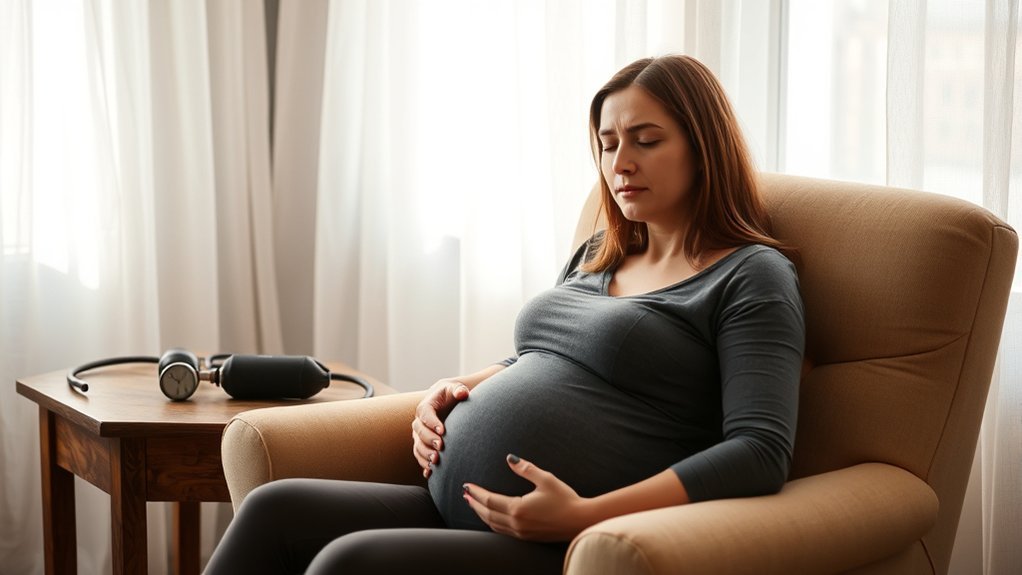Preeclampsia can sneak up on you like a thief in the night, turning an otherwise healthy pregnancy into a serious health concern. You might notice sudden swelling, persistent headaches, or changes in your vision. These symptoms can be alarming, and knowing how to respond is essential. What should you do if you experience these signs? Understanding the nuances of preeclampsia could be life-saving for both you and your baby.
What Is Preeclampsia?
Preeclampsia is a serious pregnancy complication that typically occurs after the 20th week of gestation. It’s characterized by high blood pressure and damage to organs, often affecting the kidneys and liver.
If you’re diagnosed with preeclampsia, it’s essential to monitor your health closely. This condition can lead to severe complications for both you and your baby if left untreated. Healthcare providers often recommend regular check-ups to assess your blood pressure and overall well-being.
You might also be advised to maintain a healthy diet and stay active, as these can help manage symptoms. Remember, early detection and intervention are key, so don’t hesitate to reach out to your healthcare provider if you have concerns about your pregnancy. Additionally, it’s important to be aware of signs and symptoms to ensure proper care.
What Are the Common Symptoms of Preeclampsia?
If you’re experiencing symptoms like sudden swelling in your hands and face, it could be a sign of preeclampsia.
Other common symptoms include persistent headaches, changes in vision such as blurred sight or seeing spots, and abdominal pain, particularly in the upper right side. You might also notice a sudden increase in weight due to fluid retention.
Watch for persistent headaches, vision changes, and abdominal pain, which may signal a serious condition.
Elevated blood pressure is a key indicator, often accompanied by protein in your urine.
While these symptoms can be alarming, it’s essential to remember that early detection is vital for your health and your baby’s well-being. NICHD research aims to improve health outcomes for mothers and infants, so if you notice any of these signs, don’t hesitate to contact your healthcare provider for guidance and evaluation. Your safety is paramount.
How Is Preeclampsia Diagnosed?
When your healthcare provider suspects preeclampsia, they’ll typically start with a thorough evaluation of your medical history and symptoms.
They’ll measure your blood pressure, looking for readings above 140/90 mmHg, and may ask for a urine sample to check for protein levels. If they detect elevated protein, it can indicate kidney strain.
They might also conduct blood tests to assess liver function and platelet count, which helps determine the severity of your condition.
In some cases, additional monitoring of your fetal health may be necessary.
Remember, early diagnosis is essential for managing preeclampsia effectively, so don’t hesitate to share any concerns you have during your appointments.
Your health and your baby’s well-being are the top priorities.
What Are the Risk Factors for Developing Preeclampsia?
Understanding the risk factors for developing preeclampsia can empower you to take proactive steps during your pregnancy. While the exact cause isn’t fully understood, certain factors can increase your risk. Here are some key risk factors to evaluate:
| Risk Factor | Description | Impact |
|---|---|---|
| First-time pregnancy | Higher likelihood of developing preeclampsia | Increased risk |
| Family history | If your mother or sister had it | Genetic predisposition |
| Age over 35 | Older mothers face higher risks | Elevated risk |
| Obesity | Excess weight contributes to complications | Increased likelihood |
| Chronic hypertension | Pre-existing high blood pressure | Direct correlation |
What Should You Do if You Experience Symptoms?
Experiencing symptoms of preeclampsia can be alarming, so it’s essential to act promptly. If you notice signs like severe headaches, sudden swelling, or changes in vision, contact your healthcare provider immediately.
They’ll likely recommend monitoring your blood pressure and may perform additional tests to assess your condition.
Don’t hesitate to seek emergency care if you experience severe symptoms such as abdominal pain or shortness of breath. Your health and your baby’s well-being are paramount.
Keep a record of your symptoms, including when they started and their severity, to help your doctor make informed decisions. Additionally, early intervention can be crucial in managing high-risk pregnancies effectively and ensuring the best outcomes for both you and your baby.
Frequently Asked Questions
Can Preeclampsia Affect Postpartum Recovery?
Yes, preeclampsia can impact your postpartum recovery. It may lead to complications like hypertension or organ damage, which could prolong your healing process. Monitoring and managing these effects are essential for your overall well-being.
Is There a Genetic Component to Preeclampsia?
Yes, there’s a genetic component to preeclampsia. If you have a family history of preeclampsia, your risk might increase. It’s important to discuss your family history with your healthcare provider for personalized advice.
How Does Preeclampsia Impact Future Pregnancies?
Preeclampsia can increase your risk of future pregnancy complications, including recurrence in subsequent pregnancies. Monitoring and managing your health before and during pregnancy can help mitigate these risks and guarantee better outcomes for you and your baby.
Are There Long-Term Health Effects After Preeclampsia?
Yes, you might face long-term health effects after preeclampsia, including increased risks for cardiovascular disease, hypertension, and kidney issues. It’s crucial to monitor your health and consult with your healthcare provider for ongoing care.
Can Lifestyle Changes Reduce Preeclampsia Risk?
Yes, lifestyle changes can greatly reduce your preeclampsia risk. By maintaining a healthy diet, engaging in regular exercise, and managing stress, you’re not just enhancing your overall well-being but also promoting a safer pregnancy for yourself.
Conclusion
Preeclampsia poses perilous problems for both you and your baby, so it’s essential to stay vigilant. If you notice sudden swelling, severe headaches, or vision changes, don’t hesitate to seek help. Early detection is your best defense against dangerous complications. Remember, prioritizing your health and your little one’s well-being can pave the path to a safer pregnancy. Stay informed and proactive; your awareness can spark significant change in your care and outcome.
